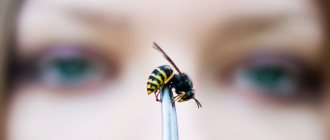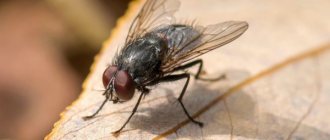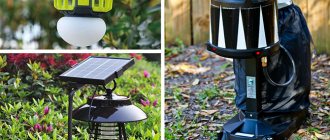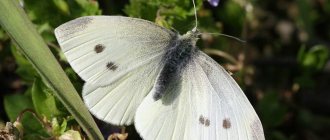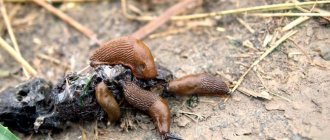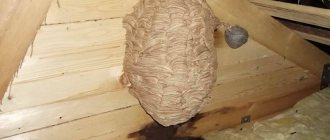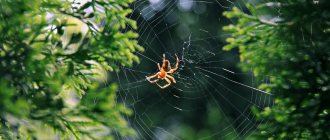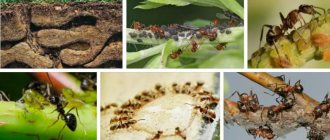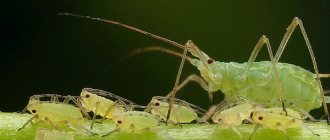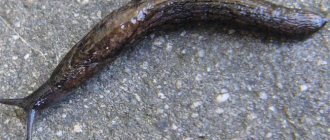Attic beekeeping
Attic beekeeping is considered a type of pavilion keeping insects. In this option, no additional fencing of the apiary is required, and there is no need to be afraid that the bees will bite random strangers.
Is it possible to equip a hive in the attic of a residential building?
You should not think that setting up an apiary under the roof of a house is only worth it if there are no more suitable places. The upper location of the hives has a number of other advantages, which we will consider in more detail below. For attic storage, compact twelve-frame Dadan structures consisting of two buildings, with a hinged rear panel, are most suitable. Ruta hives, installed in several levels, are also good in such situations.
An apiary can not only be placed in the attic under the roof; in certain situations, this is the most suitable place. But it is necessary to provide the insects with absolute peace, and this is quite difficult to do in a noisy house.
Advantages of the method
Advantages of keeping hives in the attic:
- apiary productivity increases;
- isolation from people and animals;
- working with insects does not depend on weather conditions and time of day;
- there are no sharp temperature fluctuations, high-quality ventilation and additional insulation in the cold season;
- the service life of the hives increases;
- possibility of using electric heaters;
- It is permissible to make hives from plywood.
Hive placement rules
Before setting up an apiary in the attic, it is worth familiarizing yourself with the basic rules and principles of pavilion placement. To prevent aggression and restless reactions of insects, they should equip a landing zone. Insects collecting nectar and carrying it to the hive should not be disturbed or disturbed by anything along the way.
It’s good if this is one of the walls of the barn, which has almost no movement of random and strangers. An excellent solution would be a small front garden, located on the south or east side, fenced with green spaces.
It is recommended to insulate the attic. The simplest option: lay polystyrene foam or a layer of sawdust mixed with lime (20:1) on the roofing material. Instead of roofing felt, you can use more modern vapor and waterproofing. Additional external insulation is made from materials that allow steam to pass through, since there should not be a high level of humidity inside the room.
A small space is allocated in the attic for storing frames, honey, bee bread, tools, etc. There is no need to insulate it, but lighting and ventilation are necessary.
If there are up to ten hives in the attic apiary, they can all be turned with their facades in one direction. It is better if it is east or south. When the number of hives is larger, they are installed facing both indicated cardinal directions.
Holes in the walls from the inside along the contour are lined with 20 x 25 mm slats. This makes it easier to align the hive entrances with the holes in the walls.
Attic arrangement and sound insulation
An important element in arranging an attic apiary is the presence of high-quality vibration and sound insulation. To prevent insects from becoming restless, they should be protected as much as possible from any signs of life below. You can do it like this:
- Cover the attic floor with a mixture of sawdust and lime (20:1) with a layer of 160-200 mm.
- Place a shield made of boards at least 5 mm thick on the pillow. Lay it so that it does not touch the walls and ceiling.
- Cover a wooden board with warm linoleum, on which to install the hives.
In winter, peace and quiet are of particular importance for insects. At this time, bees should not be disturbed by any extraneous sound; the beekeeper’s task is to create such conditions.
Keep in mind! One of the mandatory activities carried out in the apiary is working with a smoker. Do not forget to equip a window for smoke exit; it is better to make it on the same wall where the entrances are located.
Lighting and ventilation
It is more advisable to make the lighting combined - ordinary electric from LED or fluorescent lamps, and windows. As soon as the hives open, the bees usually head straight to the lamps. When there are a lot of bees, turn off the light for a couple of minutes and then open the window.
When working with insects, turn on the lights or open the windows located next to the hives. Light bulbs are placed higher than windows to make it easier for bees to leave the attic.
Keep in mind! 3-4 multi-hull hives are equipped with lighting from a pair of electric lamps and one window with dimensions of approximately 30 x 80 cm.
Harm and benefit
Before poisoning bees, scaring them away or moving them to another place, it is worth assessing the benefits and damage that insects can cause. Both wild and domestic honey bees are the main pollinators of garden and vegetable crops. Their presence is a guarantee of a good harvest.
However, too many insects or poor placement of the nest, such as inside a wooden wall, pose a danger. Domestic bees rarely attack first; wild bees are much more aggressive and their poison is stronger. If a swarm lives right in a window frame or in a wall, such a neighborhood poses a threat.
Which is better: a cowshed or a barn?
If there is a choice between a barn and a barn in which pets are not kept, it is naturally better to give preference to the second option. Neither a cattle barn nor a poultry house are suitable for placing an apiary.
Firstly, such a neighborhood does not meet sanitary standards. Secondly, bees often react aggressively not only to living creatures that create disturbance, but also to the characteristic odors that accompany them.
Keep in mind! Veterinary standards prohibit locating an apiary at a distance closer than 1 km from livestock or poultry farms. Otherwise, the risk of outbreaks of infectious diseases increases.
Keeping bees in the attic allows you to easily and effectively organize the wintering of insects. The beekeeper does not need to worry about additional insulation of the hives or bringing them into the omshanik for the winter. Insects also respond well to such placement, provided that they are not disturbed by extraneous noises and odors.
How to make an urgent flight of bees in the attic?
If, during a regular inspection, you notice traces of diarrhea in the hive and hear excessive buzzing of insects, you need to organize an extraordinary flight for them. Most likely, the working women simply will not live to see spring.
To prevent this from happening, the temperature in the attic rises to 20-22 °C. With this heating, the bees under the roof fly out of the hive and defecate. Then the temperature gradually decreases. To make insects fly out of their homes more actively, you can hang jars of syrup on the ceiling, after tying them with gauze.
Fighting methods
Getting rid of bees involves 2 main solutions: repelling and destroying. If insects fly from a neighboring area where their hive is located, the simplest means are sufficient. For example, an unpleasant odor causes most bees to fly away from an area. However, the substance must be selected taking into account the “taste” of honey collectors. Such an effective insecticide against pests as birch tar hardly scares bees.
If a nest is found on the site - a mink in a garden bed, a hive in a wooden wall - more drastic methods are used. It is best to lure the bees out of the nest and transport the swarm to the forest. As a last resort, they are destroyed.
Folk remedies
There are many ways to repel or poison insects. Their habits are well known, so it is not difficult to find the most accessible and safe way. You shouldn’t try to destroy them right away: there are many ways to force bees to leave their hive.
Peppermint and clove essential oil
Insects are very sensitive to odors. The simplest folk remedy for getting rid of bees in the country is the essential oil of cloves, mint, and mustard. They can't stand these scents.
Aroma lamps generously seasoned with essential oil are placed along the fence from which insects fly. An alternative option is to place pieces of fabric soaked in an aromatic substance on the fence.
Candles with citronella provide the same effect. Burning candles are placed along the veranda or on the table where the evening is spent. The aroma repels not only bees, but also mosquitoes.
To protect yourself from their attention, just drop a drop of mint or clove essential oil on the bend of your elbow and in the hollow between your collarbones. You can use a repellent containing similar essential oils.
Bags of mothballs
The smell of mothballs also irritates insects. Linen bags are filled with mothballs and hung on the fence, on fruit trees, on the walls. The aroma is so unpleasant to bees that it can force them to leave the hive if they have settled, for example, in the hollow of an apple tree.
Vinegar solution
If honey collectors are interested in the source of water at their summer cottage, then you can get rid of them by setting up water traps. To do this, cut off the top 1/3 of the plastic bottle and insert it with the neck down. The container is filled with a vinegar solution: 15 ml of ordinary essence per 2 liters of water. Traps are hung along the fence on nails.
If you replace vinegar with a 2% salt solution, the bees in such a trap will die. This remedy is resorted to if a neighboring beekeeper refuses to take action: move the hives away from the fence so that the bees fly less into the area.
Basil
The smell of basil repels insects: bees, wasps, mosquitoes. However, only fresh living leaves have this property. To protect yourself from invasion, basil is planted along the fence or around the veranda. The plant is well accepted, but needs abundant watering, and most importantly, solar warmth. Basil will not grow in the shade.
Onion garlic
The pungent smell of plants irritates the human sense of smell. It is intolerable to bees. A bed of garlic or onions, planted along a fence or just in the garden, will repel almost all insects.
Interesting! Feeding bees with onions and garlic in sugar syrup increases immunity and prolongs their life.
Live mint or lemon balm repels insects no worse than essential oil. The plant easily takes root in almost any soil and does not require care, although it prefers sunny areas. The bed is laid out along the fence or next to the house.
Citronella, a lemongrass plant, has the same effect. They grow it more often in pots than in garden beds, and in the summer they take it outside and install it along the veranda.
Lavender
Beautiful unpretentious flowers drive away wasps, bees, and mosquitoes. The plant is not afraid of common pests, so lavender can be planted right under a window or near the veranda. Dried flowers - whole or in sachet form, for example, are not as effective.
Sagebrush
It not only irritates wasps and bees, but can also poison, since the plant sap contains toxic substances. Not everyone likes the specific smell of wormwood, so they try not to plant it near the house. But a few bushes along the fence or near the garden will force honey collectors to fly around the dacha plot.
Citrus juice
The smell of lemon and orange is unbearable for honey collectors. Citrus juice is used to wipe wooden parts: window frames, doors or even walls. If a swarm has settled inside the beam, lemon juice is dripped directly into the bee passages.
Dried orange or lemon peels will help repel insects. They are laid out in living quarters, on the veranda or in places where bees and wasps are spotted.
Prevention of occurrence
It is unwise to completely get rid of bees: they are the main pollinators of plants. To prevent them from entering the house or to prevent a re-invasion, perform the following actions:
- wooden walls, window frames and doors are painted, as the smell of paint repels bees;
- spray verandas and windows, as well as living quarters with sprays or wipe the surface with mint decoctions and tinctures;
- in places where insects are spotted, lay out the peels of lemon, orange, and tangerine;
- cracks in window frames and doors are sealed with sealant;
- Plants that repel insects are planted around the house or along the fence.
Village apiary
With an apiary in the village, as a rule, things are simpler. Especially if the countryside is located far from cities, and the settlement has few inhabitants. In this case, the beekeeper is given a certain freedom of action.
It may turn out that the site is separated from its closest neighbors by hundreds or even tens of meters, and there are ecologically clean meadows, fields and forests all around. In such favorable conditions, all that remains is to worry about proper protection of the hives from the prevailing winds and the hot summer sun.
When installing bee houses, you should avoid open areas without vegetation in the form of trees or tall bushes. As well as damp areas near water bodies, where the soil and air are saturated with moisture.
The optimal location is dry, gentle slopes in the south and southeast of the site. Here, rain and melt water quickly leaves the bee spot - it dries well even in early spring and late autumn.
You can read more about the correct placement of a home apiary within any populated area here: How to properly organize an apiary from scratch
A simplified method of keeping bees in two buildings
This method of keeping bees in two frames involves placing 2 frames at the top of the hive. They select offspring of different ages and transfer them to the 2nd floor of the hive, and place honey and bee bread on the edge. The vacated space in the lower tier is replaced with honeycombs with foundation.
At first, several frames installed in the upper tier of a double-hull hive should be separated by a board. The foundation is placed in the same part of the space. So, the queen moves to the designated place and actively lays eggs in the free combs. Squads of worker insects engaged in the formation of new honeycombs on the 2nd floor are protected from swarming.
Advantages
It should be noted that such a structure has a number of advantages in comparison with the same single-hull twelve-frame structure. After all, there is not enough volume in it to increase the strength of a family of bees, moreover, this affects the large unemployment of working individuals, which, in turn, leads to swarming.
Problems with feeding in conventional hives
In addition, ordinary hives often have extensions of different sizes, which complicates not only the rational use of honeycombs, but also the preparation of feed for the winter period. It is also worth clarifying that the highest quality honey is collected in half-frames, which are placed in extensions. It is also pumped out for sale. And by the fall, the nesting combs have a product of lower quality, which, as a rule, is always insufficient to feed the family in the winter. That is why there are often cases when beekeepers feed their bees with pumped-out honey. However, in this state it crystallizes much faster, which is why its nutritional value for the insects themselves drops sharply.
In what cases should you choose a double-hull?
Although a two-body hive allows you to avoid such shortcomings, its use is by no means advisable everywhere. The fact is that it is great for places where the main bribe during honey collection is very high, or, in extreme cases, just good. In addition, the hives are suitable for strong bee families, since the weak ones will not be able to handle both bodies, and if they focus on their expansion, they will bring very little honey and other products.
Do-it-yourself cassette pavilion Berendey
Connecting the layer with the main family
Keeping honeybees in double-hulled hives with a wire mesh allows for the presence of 2 queens at the same time. This method makes it possible to strengthen the colony by the beginning of the honey collection season, as well as prevent swarming. Layering is done only in cases of late honey harvest season or overcrowding of the hive. Lack of load and a large number of insects in one hive are considered the main reasons for swarming. If expanding the internal space of the hive is impossible, it becomes necessary to form a layer.
Varicose veins: treatment with bees
Fully occupied 12 frames at the bottom of the double-hull hive allow for layering. To do this, take a couple of frames containing printed brood and adult bees and transfer them to the second floor. Additionally, honeycombs with food are installed. It is important not to relocate the old queen along with the offspring.
On the hive from which the brood was taken, a superstructure is installed with a tap hole in the other direction. It is best to do this in the early morning, and in the afternoon a young queen is allowed to move in. However, she must be kept separate from everyone else. She is released only after a day, and after another 14 days she begins to actively lay eggs. You can eliminate hostility between the mature and new uterus by installing a solid partition.
Connecting the layer with the main family just before the start of honey collection. To do this, the mature uterus is fenced off, the partition is removed and the frames are grouped in a new way. The lower part of the double-hull hive should contain open brood, and the printed brood should be placed in the upper part. At the same time, stores for collecting honey are being installed.
Construction of a double-hull hive
Today you can buy or custom-make any hive. Or you can do it yourself. We will not dwell in detail on its manufacture; we will note only a few mandatory parameters:
- roof with ventilation holes covered with mesh;
- liner (for insulation);
- ceiling;
- double diaphragm separating the two bodies;
- bottom.
It is more convenient if the design is collapsible so that the top part can be removed. Entrances are made in both parts of the hive. The diaphragm is made from bars. If a bee colony with one queen lives in a two-hull hive, then no additional protective net will be needed.
If a young queen is placed in the upper body, the diaphragm is reinforced with a fine mesh, blocking the path of the old queen and drones. When forming a layer in the upper part, the two buildings are separated by a blind removable partition.
The only drawback of double-hulled bee keeping, according to beekeepers, is the heavy weight of the structure. The upper part can weigh 45 – 50 kg. It is quite difficult to remove it alone, and this has to be done every time when pumping out honey.
Features of making a hive
Drawing.
The structure of a single-hull hive with two magazines on the left - a cut along the frames; on the right is a cut across the frames. The most famous type of single-body hive is the Dadan device, which is in extraordinary demand among beekeepers. It is made with your own hands, using available materials and tools. To do this, you will need a wooden board, for example, willow or linden, since they contain resin. If it is not possible to use these raw materials, pine or spruce will do. A special machine designed for wood processing is suitable as a tool. In addition, prepare glue, paint and other tools for the hive.
Preparatory measures for creating a single-hull hive for bees:
- The wood is processed, the approximate thickness of the board is forty millimeters. The boards are useful for the body and bottom of the hive;
- corresponding grooves are cut out that will connect the walls of the housing;
- a cutter is used to connect the boards together, leaving a gap of seven millimeters (in the center of the board connection);
- prepare thin planks with the appropriate size, namely 18 mm by 4;
- to create a single shield, the grooves are coated with glue, you can use PVA;
- it turns out about 5 shields, 4 of which will play the role of walls, and the 5th - the bottom;
- using nails and glue, assemble several single-hull Dadan hives;
- then they paint over the created structure;
- make holes for tap holes;
- making the liner.
It is important to use diagrams or ready-made drawings during the manufacturing process so that the structure has the appropriate dimensions. The width of the front shield is 530 millimeters, the thickness is 40 millimeters, and its height is 320 mm. The rear shield has similar parameters. As for the side wall, its height is 320 millimeters, its width is 480 mm, and its thickness is about 40 millimeters.
